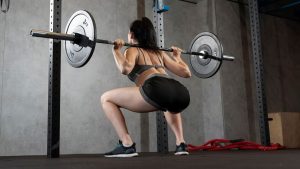The Order of Workouts: Squats vs. Back & Biceps

Understanding the Choices
Squats First
Squats engage multiple muscle groups, primarily targeting the lower body quadriceps, hamstrings, glutes, and even the core. Starting with squats allows you to focus on compound movements that require more energy and overall body stability. By doing squats first, you benefit from having more energy and strength to execute this fundamental exercise effectively.
Back & Biceps First
Initiating your workout with back and biceps exercises can be beneficial if your primary goal is to emphasize upper body strength and development. Working on these muscle groups early allows you to concentrate on specific isolation exercises that target the back and biceps without the fatigue that compound movements like squats might induce.

Factors to Consider
Energy Levels: Consider your energy levels during the workout. Squats demand considerable energy, so if you prefer tackling the most demanding exercises upfront, starting with squats might suit you.
Fitness Goals: Your goals matter. If your focus is on lower body strength or overall muscle development, squats first might be advantageous. For upper body emphasis, beginning with back and biceps exercises could be more beneficial.
Preferential Order: Personal preference plays a crucial role. Some individuals find that starting with squats helps them activate multiple muscle groups and primes their body for subsequent exercises. Others might prefer beginning with upper body exercises to conserve lower body strength for later.
So.
There’s no one-size-fits-all answer to whether you should squat first or start with back and biceps exercises. It largely depends on your fitness goals, energy levels, and personal preferences.
Experimentation might be the key. Try alternating your workout sequences and observe how your body responds. Listen to your body’s cues and adapt your routine based on what feels most effective for you and aligns with your fitness objectives.
The Science Behind Exercise Sequence
Understanding the science behind exercise sequencing can further illuminate the decision-making process when determining whether to start with squats or back and biceps exercises.
Muscle Activation
Research suggests that exercise order can influence muscle activation. Compound exercises like squats engage multiple muscle groups simultaneously, leading to greater overall muscle recruitment. Initiating your routine with compound movements could prime your body for subsequent exercises by enhancing overall muscle activation.
Fatigue and Performance
Exercise sequence can also impact fatigue levels. Starting with a high-intensity exercise such as squats might lead to earlier fatigue, potentially affecting performance in subsequent exercises. On the other hand, beginning with smaller muscle group exercises (like back and biceps) could allow for better execution and focus on those specific muscles.
Metabolic Response
The sequence of exercises can affect the metabolic response of your body. Compound movements, like squats, can elicit a more significant metabolic demand, potentially leading to a greater post-workout calorie burn. This could be advantageous if your goal includes fat loss or improving overall metabolic health.
Finding Your Optimal Sequence
While scientific studies offer insights, the best sequence remains highly individualized. Here are a few considerations to find your optimal sequence:
Trial and Observation: Experiment with different sequences over a few weeks and observe how your body responds. Notice your energy levels, muscle fatigue, and overall performance during the workout.
Goal Alignment: Tailor your sequence to align with your fitness objectives. Whether it’s strength gain, muscle building, or overall fitness, choose the sequence that best supports those goals.
Body Signals: Listen to your body. If you notice better performance or reduced fatigue with a specific sequence, it might be the right fit for you.
Consultation: If possible, seek guidance from a fitness professional or personal trainer. They can provide personalized recommendations based on your goals and body type.
In Conclusion
The ideal sequence for your workouts is a blend of science and personal experience. Understanding the impact of exercise order on muscle activation, fatigue, and metabolic response can guide your decision-making process.
However, the most crucial aspect is to enjoy your workout and stay consistent. Whether you choose to start with squats or back and biceps exercises, consistency and dedication to your fitness routine will bring the most significant results.
External Resources
For deeper insights into exercise sequence and its impact on workouts, these resources provide valuable information:
American Council on Exercise – Exercise Order Matters
PubMed Central – Effects of Exercise Order on Muscle Strength Development
ScienceDirect – Acute Effects of Exercise Order on Muscle Fatigue
Bodybuilding.com – The Best Workout Order
Men’s Health – The Perfect Workout Order
Healthline – Exercise Order: Does It Matter?
Remember, the best sequence for your workouts is the one that aligns with your goals and leaves you feeling empowered and motivated. Happy exercising!
Comparison tabular on this
Here’s a comparison table summarizing the key aspects of starting with squats versus beginning with back and biceps exercises in a workout routine:
| Aspect | Starting with Squats | Starting with Back & Biceps |
|---|---|---|
| Muscle Activation | Engages multiple lower body muscles, core, and promotes stability | Targets specific upper body muscles (back, biceps) without exhaustion |
| Energy Levels | Demands considerable energy, potentially affecting later exercises | Allows conserving lower body strength for later exercises |
| Fatigue Levels | May induce earlier fatigue, impacting performance | Likely less fatigue initially, better focus on upper body exercises |
| Metabolic Response | Greater metabolic demand due to compound movement | Lower initial metabolic demand, focusing on specific muscle groups |
| Considerations | Ideal for lower body strength and overall muscle development | Suited for emphasizing upper body strength and muscle isolation |
| Impact on Workout | Can prime the body for subsequent exercises | Enables focused attention on specific muscle groups |
This table provides a concise overview of the implications of starting with squats versus back and biceps exercises, helping you consider various factors when designing your workout routine.
Wrapping up
In the realm of fitness, the debate between starting with squats or beginning with back and biceps exercises isn’t about a definitive right or wrong. Instead, it’s about finding what feels most effective and rewarding for you.
Experimentation is your ally. Try different sequences, observe how your body responds, and listen to its cues. Your workout routine should align with your fitness goals and leave you feeling empowered and motivated.
Remember, there’s no universal formula. Whether you’re diving into squats first or focusing on your upper body with back and biceps exercises, what matters most is consistency, dedication, and enjoying the journey toward a healthier, stronger you.
So, find your rhythm, keep exploring, and let your fitness routine be a reflection of your goals and your passion for a healthier lifestyle. Cheers to your fitness journey!

Hey there, it’s Mike Rrsq, the Editor-in-Chief over at Jsquat.com, and I’m absolutely obsessed with all things squat fitness! I’ve been lucky enough to get some serious recognition for my work in this field. With a solid background in the fitness and wellness industry, I’ve been there right from the get-go, helping shape this website into what it is today.
You see, I’m not just the boss around here; I’m also a passionate contributor. I love sharing my insights through my articles, and trust me, they’re not your run-of-the-mill stuff. Each piece I write is a labor of love, filled with my expertise and real-world experience in the fitness universe. So, if you’re into fitness and looking for some inspiration, you’re in the right place!
Related Posts
- Can You Combine Front And Back Squats In Your Workout Routine (Explained)
You may be wondering whether it's possible to combine front and back…
- Should 18-Year-Old Female Incorporate Back Squat in Their Full-Body Workout Routine
At 18, embarking on a fitness journey can be both thrilling and daunting. With an…
- Legs not hurting after squats
Experiencing little to no leg soreness after a squat session can be quite surprising, especially…
- Given that shrimp squats are not the best for strength should I plan a routine with limited equipment
Designing a workout routine with limited equipment requires some strategic planning. Shrimp squats are indeed…
- How often should 17-year-old male include back squat in their workout routine strength
Incorporating back squats into a workout routine can significantly enhance strength and overall fitness for…
- How should 19-year-old incorporate back squat into a bodyweight workout routine
Incorporating back squats into a bodyweight workout routine at 19 years old can be a…
- When is the best time to squat during a workout?
Hey there fitness enthusiasts! If you've ever wondered when the best time to squat during…
- Are Hack Squats As Good As Squats (Explained)
Are hack squats the real deal or just a pale imitation of the classic squat?…
